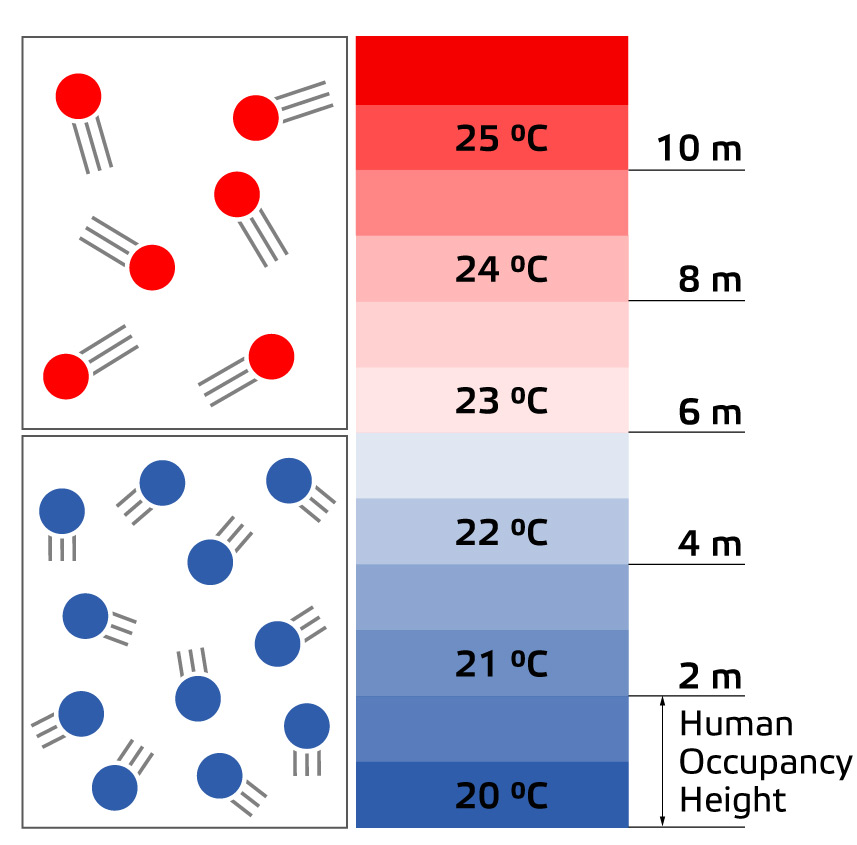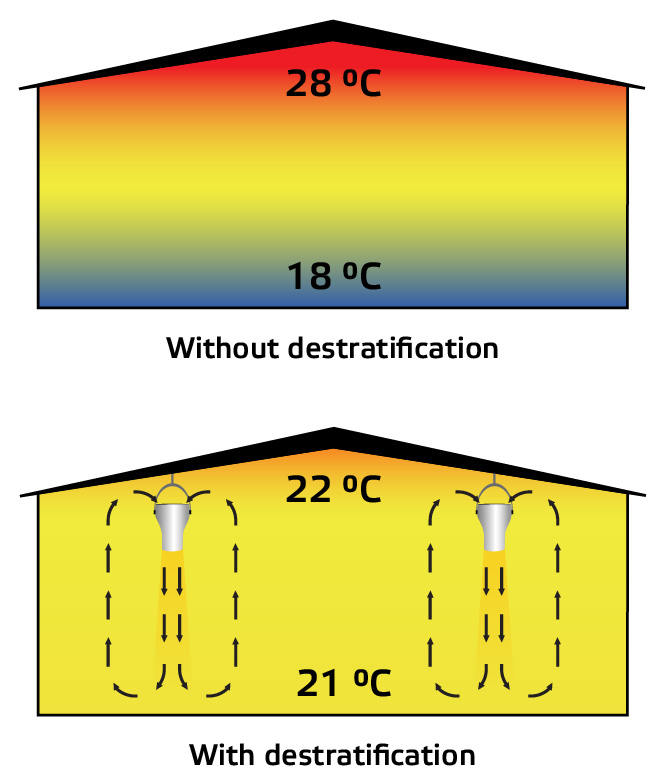How do destratification fans work?
Thermal stratification
 Thermal stratification occurs in many places: in the atmosphere, in lakes and oceans, but most importantly, indoors. Indoors, warm air rises to the ceiling and is trapped there. In environments with low ceilings, this is not a problem, as there is not much space between the ceiling and the person using the room. However, the higher the ceiling, the higher the difference between the temperature on the floor and the ceiling. For every two meters in height, the temperature will rise by about 1°C. This means that a heating system will inefficiently warm the parts of the air that are never used. The air tends to layer in air “strata” of different temperatures that will not mix easily.
Thermal stratification occurs in many places: in the atmosphere, in lakes and oceans, but most importantly, indoors. Indoors, warm air rises to the ceiling and is trapped there. In environments with low ceilings, this is not a problem, as there is not much space between the ceiling and the person using the room. However, the higher the ceiling, the higher the difference between the temperature on the floor and the ceiling. For every two meters in height, the temperature will rise by about 1°C. This means that a heating system will inefficiently warm the parts of the air that are never used. The air tends to layer in air “strata” of different temperatures that will not mix easily.
Working principle of destratification fans
A destratification fan will blow the warm air from the ceiling to the colder floor. This simple technique redistributes the warmth more evenly through the room. By blowing the air from top to bottom, the fan pierces through the temperature strata and forces them to mix. However, there is a limit to its effectiveness. The fan cannot cover the whole room at once. Depending on the surface area of the room, more or fewer fans will be necessary to ensure that the temperatures mix. We recommend optimizing the location of the fans to areas with high traffic.
Energy savings with destratification
With destratification, the energy that is required to have a comfortable temperature at ground level decreases. The temperature in the air at ceiling height is less high, limiting heat losses through the roof. The higher the temperature at ceiling height, the more heat is lost due to contact with the outside environment and vice versa. The temperature at ground level will be higher, with the room requiring less heating to feel comfortable.
Avoiding the dangers of condensation
Another benefit of destratification fans is that they significantly reduce condensation in rooms. Warmer air can contain higher amounts of water vapour. Upon contact with cold surfaces, the water vapour in the warm air will condense and form water droplets. This is especially an issue in poorly insulated buildings where warm air will interact with a cold roof. The danger is threefold: it can cause slipping danger, cause damage to products and equipment, and cause moulds and bacteria to form. All of these phenomena can contribute to an unhealthy and uncomfortable environment for residents. Luckily, these condensation issues can be mitigated with destratification.
Other benefits of destratification
There are some other benefits to destratification. Destratification does not require ductwork, reducing its installation cost. It causes less strain on the heating system, lengthening its lifespan. It can help you attain a green label for your building and can be supported by governments and NGOs giving out subsidies and green labels. Moreover, a destratification system greatly contributes to the comfort of employees, clients, and other residents.
 Applications of destratification
Applications of destratificationDestratification is a very good option in rooms with high ceilings. A high ceiling is a ceiling that exceeds 4,5 meters in height. With this height, there is a more than 2 °C temperature difference between the ceiling and the ground. Typical rooms with these heights are warehouses, sports areas, ballrooms, restaurants, stores, malls, factories, and exposition halls.
Sentera products suitable for destratification
Sentera has controllers for AC and EC destratification fans. The TCMF8 controllers can control multiple AC fans at the same time. The ECMF8 controllers can control multiple EC fans. Both fan controllers are compatible with demand-based fan speed control in combination with two temperature sensors, one at floor level and one at ceiling level. With demand-based fan speed control, the fan will only run when the temperature difference between the ground and the ceiling exceeds a certain threshold. This results in even greater energy savings!
Cooling with destratification fans
So far, we discussed the application of destratification during the colder seasons, when it helps ensure that heat remains at ground level. Nevertheless, in some circumstances, they are also helpful for air conditioning in the warmer seasons of the year! This is very evident in areas with much machinery. As these machines can produce much excess heat, and as the temperature strata do not mix easily, this can result in an unbearable heat trap. Piercing through the temperature strata may then have the opposite effect and actually cool the ground level faster.
